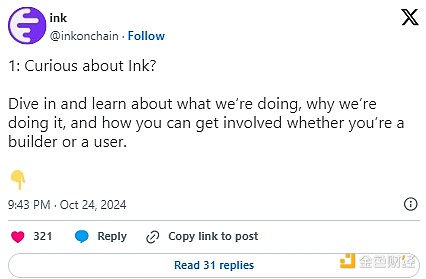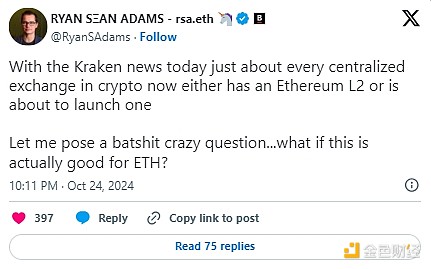Author: Kazu Umemoto, Bankless; Compiled by Tong Deng, Jinse Finance
One of the biggest trends in DeFi last year was the steady rise of Coinbase's Base network. But after its Total Value Locked (TVL) soared to the peak of L2, Base now has a very clear goal.
Kraken is ready to join the fight.
The centralized exchange will launch a new Optimism-based aggregator called "Ink". Following the big hype around Unichain, Kraken is now entering the ever-evolving Superchain ecosystem.
Let's dive into what Kraken is building with Ink, why they chose Superchain, and how Ink plans to stand out in the increasingly crowded Rollup ecosystem.
I. The Vision of 'Ink'
Like Coinbase, Kraken is providing a suite of DeFi tools, including staking and spot trading, as well as self-custody wallets. The next natural step for both companies is to encourage users to migrate on-chain.
This is where Ink comes in. Kraken's goal is to scale their own L2 and leverage the trust they've built with their existing customer base. Just as Coinbase is trying to cleverly attract users to use their on-chain trading products through tight integration with Base, Ink may become the go-to destination for Kraken traders.
The trajectory of Ink will depend on whether Kraken succeeds in attracting the best developers in the space to bet on their fledgling L2. Ink plans to launch its testnet at Devcon in Bangkok later this year. The mainnet is currently slated to go live in early Q1.

II. Will There Be an Airdrop?
Okay, the first thing you're probably wondering about is whether there will be an Ink airdrop opportunity. As of now, just like Base, the answer is no.
Ink founder Andrew Koller stated that there are currently no plans for an Ink token.
In this regulatory environment, this is not surprising. Kraken is avoiding issuing tokens that could potentially be challenged by regulators. While investors still hope that their on-chain activity on Base will one day earn them token allocations, the company's official stance is that there are no token plans at the moment.
III. Are Coinbase and Coinbase Kraken Competitors?
On the surface, Kraken and Coinbase seem aligned, both committed to the shared goal of onboarding as many users as possible onto the chain. However, they are still direct competitors, and Kraken's foray into L2 can easily be interpreted as a strategic response to the breakthrough success of Coinbase Base.
Kraken started developing their own chain about a year ago, around the same time as Base's launch, indicating they understood the opportunity and the urgency.
Nevertheless, these two blockchains still benefit each other. Optimism co-founder Ben Jones points out that Superchain's goal is to facilitate growth and positive economic impact for all participants, just like the interstate highway system in the US, by allowing liquidity to flow freely between blockchains. What's good for Base is also good for Ink, and vice versa.
Introducing more exchange-backed L2s may help foster healthy competition in the decentralization process. Initially, Ink's team will serve as the sole on-chain sequencer for the network, but they plan to gradually decentralize the network's operations. Meanwhile, over a year after launch, Coinbase has officially announced that Fault Proof will go live on Base later this month. This marks an important step forward, but also indicates that achieving full decentralization is a gradual process.
IV. Has Superchain Won?
With Kraken joining Superchain, the optimism around the ecosystem is soaring. Superchain currently processes around 7 million transactions per day, nearly half of all L2 activity. This number is expected to rise further with the upcoming launch of Unichain and the continued development of the ecosystem.
Another key reason to be bullish on the Superchain ecosystem is the seamless SuperchainERC20 token standard. While it may seem small at first glance, this new standard solves a major problem when attempting to transfer liquidity between L2 chains.
With the SuperchainERC20 token standard, users can now easily move liquidity between chains within the Superchain ecosystem without the need for back-and-forth bridging. This solution significantly reduces Gas costs and eliminates the security issues associated with traditional bridges, making cross-chain liquidity transfers more efficient and secure.
Kraken has committed to sharing a portion of Ink's network revenue with the Optimism Collective and supporting the core development of the OP Stack. The participation of major players like Kraken and Coinbase is a huge win for Superchain, further cementing its position as the preferred DeFi infrastructure for users.

V. The Value of Ink
L2s are becoming increasingly crowded; that's undisputed.
For those concerned that Rollup-centric scaling is eroding Ethereum's advantages, another L2 launch may become another data point to support their skepticism. But for those who believe we are still in the early stages of a long journey to bring the world onto the chain, a trusted exchange making a major public bet on decentralized finance is huge.
With more blockchains joining, Superchain is becoming a one-stop shop for DeFi, and with Kraken's 10 million existing customers, Ink presents a massive opportunity for our space.






